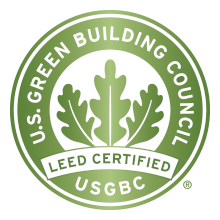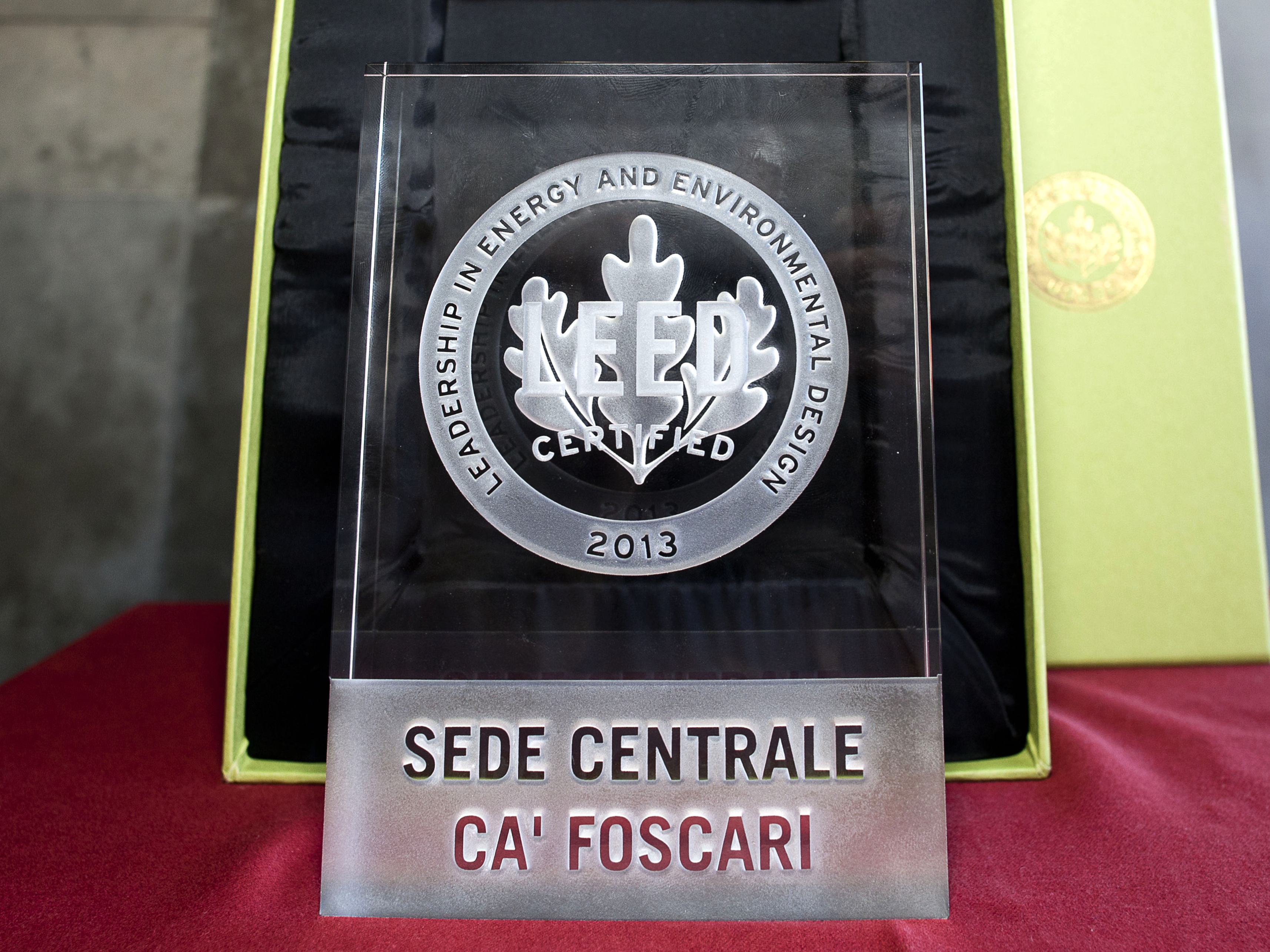LEED certification
LEED® - Leadership in Energy and Environmental Design is an energy and sustainability certification standard promoted by the U.S. Green Building Council that certifies the level of sustainability of a building: a set of criteria for the design, construction and management of buildings that are sustainable from an environmental, social, economic and health perspective.
The certification is awarded by assigning a score depending on the achievement of measurable requirements - from energy consumption to indoor environment quality - which define the level of environmental impact of buildings in the various areas of sustainability. There are 4 levels of certification - certified, silver, gold, platinum: the higher the number of points achieved, the higher the level of certification the building obtains.
Ca' Foscari University of Venice has achieved the LEED certification - existing buildings - SILVER level for its headquarters in Palazzo Foscari.
The LEED certification - new buildings – GOLD level is being obtained for Epsilon, the seventh building in the Scientific Campus, opened in autumn 2021.
About the LEED certification for new buildings
The LEED certification for new buildings is known as LEED BD+C: NC, which stands for BUILDING DESIGN AND CONSTRUCTION: New Construction.
The certification process aims at the construction of buildings through coordinated design and execution of works within nine thematic areas. Among the various areas covered are the protection of sensitive areas, the management of drinking water consumption and the reuse of rainwater, the production of energy from renewable sources and the promotion of the use of "green" vehicles (fuelled with electricity, LPG, methane). The areas for optimisation and monitoring of energy performance, air quality and reduction of the impact of the building's life cycle, as well as proper management of demolition and construction waste are also covered.
About the LEED certification for existing buildings
The LEED certification for existing buildings is known as LEED EB: O&M, which stands for Existing Building: Operation & Management.
The certification process for existing buildings aims at assessing and certifying the level of sustainability in the building's operations and maintenance. The protocol also suggests a series of improvement actions by prioritising low-impact and low-cost interventions and focuses on the daily practices and behaviour of the building's residents, as well as providing for energy audits and measurements of the building's sustainability performance.
Palazzo Foscari - SILVER certification
On 19 September 2013 Palazzo Foscari, the Gothic building on the Grand Canal of Ca' Foscari University of Venice was officially awarded the LEED EB: O&M certification for existing buildings, thus becoming one of the oldest buildings in the world with this award.
On 23 November 2018, the building was awarded the higher level of certification (Silver), as a proof of the University's care for the management and maintenance of the building through the development of sustainability actions.
The goal achieved by Ca' Foscari is the result of the partnership with Habitech, a consultant for the sustainable renovation of existing buildings.
Why this certification for Palazzo Foscari
Ca' Foscari is also an important case study because of its operating context, characterised by few possibilities of intervention. Indeed, it is a historic 16th century palace, subject to historical-artistic protection and which has already undergone extensive renovation in its recent past.
The certification obtained by the University is a valuable reference tool and represents an opportunity to promptly reduce pollution and cut operating and maintenance costs.
The challenge for the future will be the spreading of the know-how along with the application of the energy efficiency criteria of LEED certification to other old buildings in Italy. This experience will hopefully lead to reflect on the actual need for overall energy savings for other similar buildings.
Epsilon @Scientific Campus - GOLD Certification
Being obtained
Epsilon, the seventh building of the Scientific Campus, located in Mestre, on the mainland of Venice, was opened in September 2021.
Built in less than two years, Epsilon is one of the University's most sustainable buildings, thanks to the technical solutions adopted and the materials used. The building was designed to be at least LEED certified, but the choices made during the construction phase have allowed the University to aim for GOLD certification.
The characteristics of Epsilon for LEED certification
SUSTAINABLE MOBILITY
Two charging stations for electric cars have been installed in the area outside the building along Via Torino. Therefore, 6 charging points for cars are now available on campus, while a special shelter with photovoltaic panels has been installed to charge electric bicycles. Moreover, dedicated parking spaces have been reserved for low-emission vehicles (methane/hybrid).
CLIMATE CHANGE ADAPTATION
In order to minimise the so-called “urban heat island” phenomenon, i.e., the rise in temperature typical of urban areas and the effects on indoor microclimate inside, the building was fitted with a roof with a high solar reflectance index (SRI) paint, which largely reflects direct sunlight. In addition, the paving of the car parks has been made with drainage grating elements, which increases the permeable surface area and reduces the heat island effect on the ground.
WATER CONSUMPTION
In order to reduce the consumption of water needed for the toilets, low-flow taps and dual-flush and low-flow toilets have been installed.
ENERGY AND ENVIRONMENT
In order to reduce energy dispersion and increase the amount of energy produced from renewable sources, a 56.25 kWp photovoltaic system has installed on the roof. This will allow saving over 100 toe (tonnes of oil equivalent) and over 150 tCO2 eq (tonnes of CO2 equivalent). In addition, the performance of the building envelope has been verified through functional tests (Commix) to assess its quality in order to allow the achievement of the declared performance.
SUSTAINABLE MATERIALS
Low-impact materials were used in the construction phase: most are EPD (environmental product declaration) certified, a declaration which describes the environmental impacts throughout the product's life cycle. Furthermore, the products used inside the building (flooring, paints, sealants, adhesives) have low VOC - Volatile Organic Compounds - emissions to protect the health of residents and operators.
INDOOR AIR QUALITY
In order to improve and monitor the quality of the indoor environment, a BMS - Building Management System - has been installed. This is a control and monitoring system that uses sensors and software to manage heating, cooling, lighting, fire prevention and ventilation systems on site and remotely. In addition, the most crowded rooms are fitted with sensors to measure CO2
Last update: 21/03/2025


